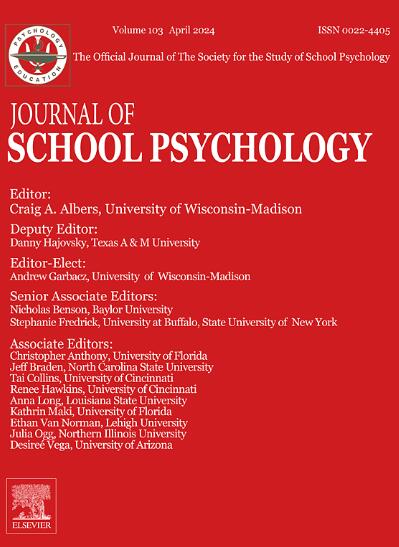Developmental heterogeneity of school burnout across the transition from upper secondary school to higher education: A 9-year follow-up study
IF 4.1
1区 心理学
Q1 PSYCHOLOGY, SOCIAL
引用次数: 0
Abstract
This study utilized piecewise linear growth mixture analysis to examine the developmental heterogeneity of school burnout among a sample of 513 (67.6% females) Finnish students as they transitioned from upper secondary school to higher education (ages 17–25 years). Encompassing five measurement points (two before the transition and three after), our results revealed four distinct burnout trajectory profiles, including (a) High and Decreasing (Profile 1), (b) Moderate and Decreasing (Profile 2), (c) Low and Increasing (Profile 3), and (d) Low and Stable (Profile 4). High initial levels of self-esteem and mastery-extrinsic goals served as personal resources and high-performance goals served as personal risk factors, making students more likely to belong to more (i.e., Profile 4) or less (e.g., Profile 1) adaptive profiles of burnout trajectories, respectively. Profile 4 displayed the lowest and most stable levels of burnout, thus protecting students from adverse outcomes like school dropout, underachievement, and substance use. Conversely, Profile 1 displayed the highest and least stable levels of burnout and was associated with higher risk of burnout, lower academic achievement, greater alcohol use and problems, and higher drug use relative to the other trajectory profiles. Together, these findings offer novel person-centered, longitudinal insight into the developmental heterogeneity of burnout across the transition to higher education and lend support for the self-equilibrium hypothesis in the context of school burnout. Importantly, our results underscore the importance of early intervention efforts aimed at increasing mastery goals and self-esteem to prevent burnout and its associated consequences.
从高中到高等教育过渡期间学校倦怠的发展异质性:为期九年的跟踪研究
本研究采用片断线性增长混合分析法,对513名芬兰学生(67.6%为女性)从高中升入高等教育阶段(17-25岁)的学校倦怠发展异质性进行了研究。我们在五个测量点(两个在升学前,三个在升学后)进行了测量,结果发现了四种不同的职业倦怠轨迹,包括(a)高且不断降低(轨迹 1),(b)适度且不断降低(轨迹 2),(c)低且不断增加(轨迹 3),以及(d)低且稳定(轨迹 4)。高水平的初始自尊和主观外在目标是个人资源,而高绩效目标则是个人风险因素,这使得学生更有可能分别属于倦怠轨迹中适应性较强(即特征 4)或适应性较弱(如特征 1)的特征。特征 4 显示出最低和最稳定的职业倦怠水平,从而保护学生免受辍学、成绩不佳和药物使用等不良后果的影响。相反,特征 1 的职业倦怠程度最高且最不稳定,与其他轨迹特征相比,它与更高的职业倦怠风险、更低的学业成绩、更多的酒精使用和问题以及更高的药物使用相关联。总之,这些研究结果提供了以人为本的纵向新见解,揭示了升学过程中职业倦怠的发展异质性,并为学校职业倦怠的自我平衡假说提供了支持。重要的是,我们的研究结果强调了早期干预工作的重要性,旨在提高掌握目标和自尊,以防止倦怠及其相关后果。
本文章由计算机程序翻译,如有差异,请以英文原文为准。
求助全文
约1分钟内获得全文
求助全文
来源期刊

Journal of School Psychology
PSYCHOLOGY, EDUCATIONAL-
CiteScore
6.70
自引率
8.00%
发文量
71
期刊介绍:
The Journal of School Psychology publishes original empirical articles and critical reviews of the literature on research and practices relevant to psychological and behavioral processes in school settings. JSP presents research on intervention mechanisms and approaches; schooling effects on the development of social, cognitive, mental-health, and achievement-related outcomes; assessment; and consultation. Submissions from a variety of disciplines are encouraged. All manuscripts are read by the Editor and one or more editorial consultants with the intent of providing appropriate and constructive written reviews.
 求助内容:
求助内容: 应助结果提醒方式:
应助结果提醒方式:


